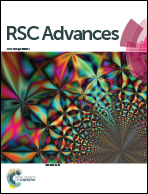Mesoporous strontium doped nano sized sulphate hydroxyapatite as a novel biomaterial for bone tissue applications†
Abstract
In this study a novel nano-structured hydroxyapatite (HA) incorporated with different fractions of Sr2+ and SO42− ions has been synthesized using the wet precipitation method and characterized. This study explored the potential benefits of dual doping of Sr2+ and SO42− ions for the first time, which would contribute to bone prosthetics' clinical success. The substitution of Sr2+ and SO42− ions into the HA crystal structure was confirmed using XRD, FTIR, Raman spectroscopy, FESEM, BET and XPS techniques. Fetal Bovine Serum (FBS) was used as a model protein for adsorption assay. FBS revealed higher affinity towards Sr-SHA materials rather than pure HA. In vitro bioactivity studies showed that the HA dissolution rate increased with incorporation of Sr2+ and SO42− ions in the HA structure. The highest dissolution rate was recorded on the 1st day of immersion in Simulated Body Fluid (SBF) for SHA and Sr-SHA groups. Intense growth of apatite grains on the surface of Sr-SHA with Ca/P ratio of (1.41–1.64) was observed after 14 days of incubation in SBF. In vitro cytotoxicity studies conducted with Sarcoma Osteogenic (Saos-2) cells showed that Sr-SHA was cytocompatible. It was observed that Sr-SHA promoted cell adhesion, spreading and proliferation of Saos-2 cells compared to pure HA. Saos-2 cells seeded on Sr-SHA had statistically higher alkaline phosphatase (ALP) activity and intracellular calcium deposition compared to HA. Collectively, our results showed that Sr-SHA materials with enhanced bioactivity, cytocompatibility and osteogenic activity hold great potential to be used as materials for bone tissue regeneration.


 Please wait while we load your content...
Please wait while we load your content...